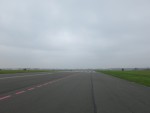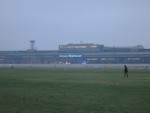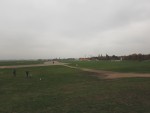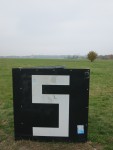Locals fought back against gentrification and saved a disused airfield for use as a giant park. Outrage over the country’s flood of colossal public works boondoggles probably helped.
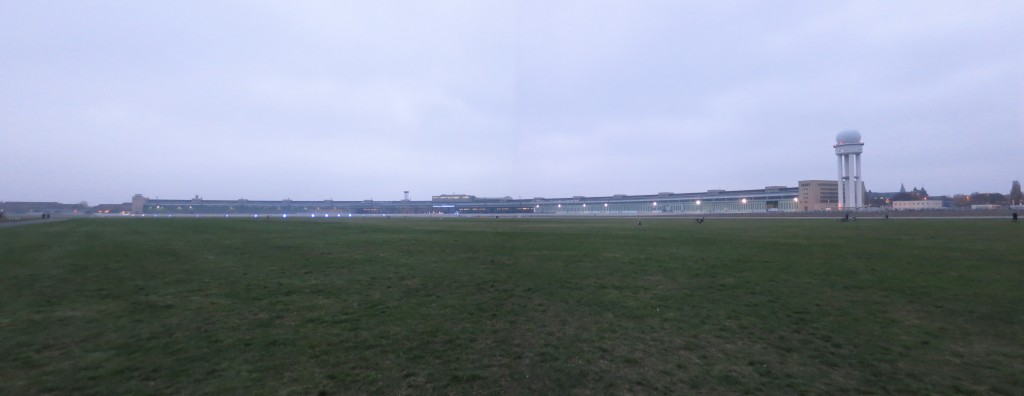
In 2014 Berliners fought for, and won, the preservation of the airfield of Tempelhof, a decommissioned airport near the city center, as an extraordinary and minimalst park – more an un-park – instead of turning it over to developers for housing-retail-office complexes. I was there in the fall and I loved the sweeping uninterrupted emptiness which in good weather fills with people doing everything people do in parks.
They didn’t just vote to keep the site as green space, they voted in a law to preserve the airfield untouched and completely ban alterations and permanent structures of any kind – but only for ten years, as I understand it. There will be no landscaping, no trees, no sports fields or playgroundsm except on a narrow outer perimeter band. Just one flat featureless grass expanse the size of Central Park, crossed, of course, by runways. In my hour or two there I saw no benches or rest rooms. (I later learned there are four restrooms on the perimiter) But that hasn’t stopped the park from becoming enormously popular.
To keep the park intact, citizens battled the combined, deep-pocketed forces of City Hall, investors and real-estate developers. The airport closed in 2008; the terminal – built by Hitler and plausibly said to have been the world’s largest building for decades afterwards – is rented out for corporate events, has some tenants such as police department offices, and is not affected by the new law. While the city prepared its plans it temporarily made the airfield available as a park. It doesn’t seem to have occurred to civic leaders that citizens wouldn’t welcome a high-end apartment-retail-office complex taking over a treasured and heavily-used park even though a good portion of it was allegedly to be retained as a fully landscaped park. A group put together a referendum, got a staggering 10% of all registered voters to sign it, and won the election 64 to 36%.
Voters rejected the city’s promises that 850 of the 4,700 apartments would be “affordable” and would help ease Berlin’s skyrocketing rents and severe housing shortage. “This government hasn’t built a single public-housing apartment in the last 10 years – are they going to start right when park-side real estate opens up?” asked one commentator. Park supporters demanded the city acknowledge its existing capacity for 200,000 new housing units in underused buildings and on vacant lots, and implement “land recycling”.
They also called the City’s bluff on extravagant and often bribe-driven public works projects. The plan surely set some sort of record for brazenness in a modern industrialized democracy. The mayor, in a city crippled by debt – none of Germany’s 30 largest public companies are headquartered there – was pushing not only for the development itself but also for a new central library on the site while in the midst of resigning due to his role as leader of Europe’s biggest, most expensive construction scandal in recent memory.
While simultaneously slashing neighborhood branch library budgets.
The scandal is the new Berlin airport. Plagued by contractor and political corruption and embarrassing engineering failures on an unprecedented scale, its cost has more than doubled. The lead engineering firm went bankrupt in mid-construction. It costs $26 million a month in upkeep to sit empty while they figure out if the fire-control system really can pump the smoke downward underneath the building because the designers thought ducts on the roof would be unsightly. The original 2011 opening date was canceled less then four weeks beforehand, after thousands of plane tickets had been sold and everything was in place and ready to go, down to the restaurants’ food orders and informing the population about closing the area’s highways for a day or two while they truck in everything not nailed down from the old airport – you know, all the things people do when they open airports. Opening is now estimated around 2017 or 2018 but the engineers have given up on setting dates. A special runway-adjacent parking platform only for the mayor and his personal entourage was budgeted at $620,000. Walls are being demolished because the wiring is wrong. Four weeks?
But this is only one of several German projects experiencing similar problems. Hamburg’s new concert hall is costing more than ten times its planned budget, 789 million euros up from 77 million. The new Stuttgart train station is so impractical and over budget that the national railway company itself, Deutsche Bahn, recently admitted in a report that the entire project was a mistake. It’s a through-corridor hub station, but Stuttgart isn’t a hub or a through corridor and never will be unless they pick up the whole city and move it 100 miles east. The cost went from 4.5 to 6.5 billion euros, construction is tearing up the entire city-center park and all its old trees, and there is one stretch of track so sloped that only the most expensive flagship high-speed trains are physically capable of using it even though the rest of the region does not have high-speed tracks. Police turned water cannons, tear gas and batons on the 100,000 people, including children, who showed up two days in a row to protest it.
Germany’s mind-bogglingly dysfunctional extravagance is appropriately summed up by the reaction of the director of the Tempelhof project, Gerhard Steindor, to its crushing defeat in the referendum vote. He was quoted as saying the voters somehow just didn’t really want to keep the airfield as a minimalist park even though they mounted a massive campaign and voted overwhelmingly to do precisely that: “I’m not sure if people wanted Tempelhof to stay exactly the way it is.”
